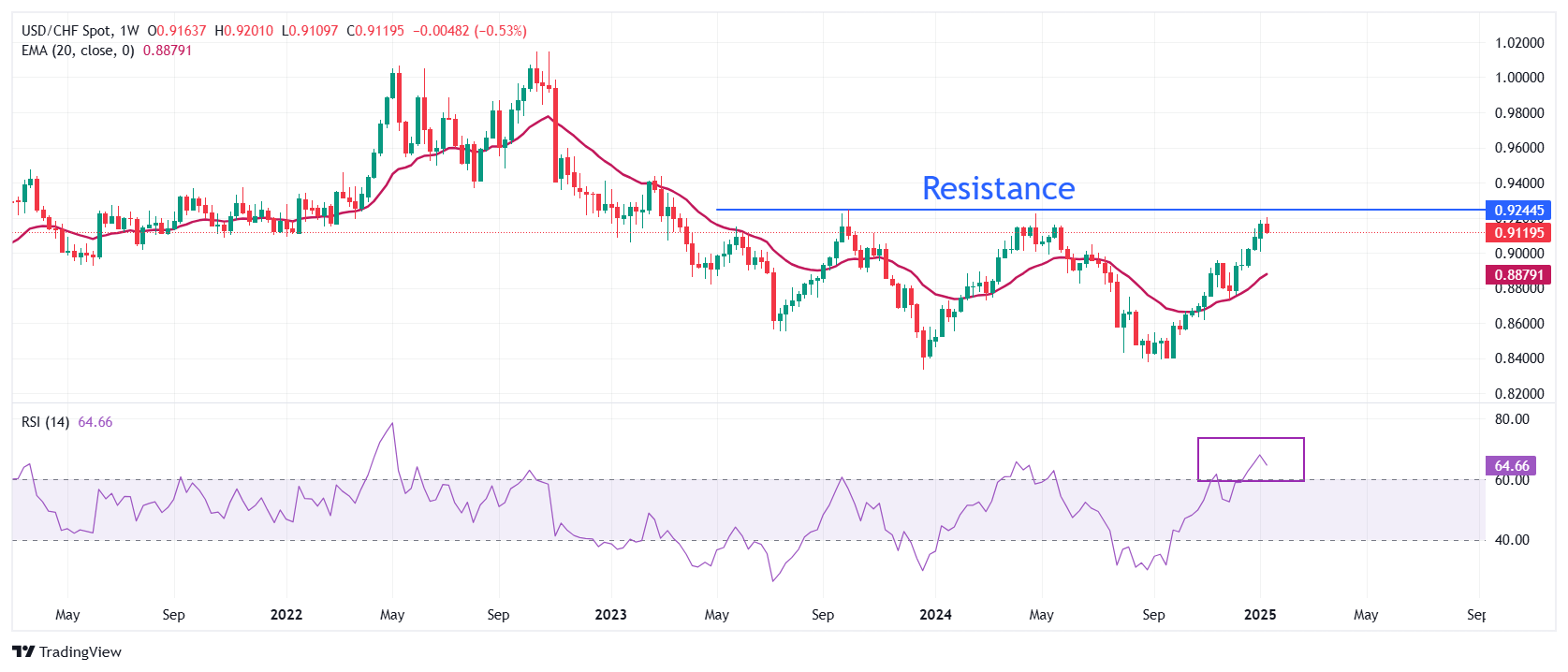- Analytics
- News and Tools
- Market News
- USD/CHF Price Forecast: Trades cautiously near 0.9100 ahead of US inflation data
USD/CHF Price Forecast: Trades cautiously near 0.9100 ahead of US inflation data
- USD/CHF appears to be cautious around 0.9100 with investors focusing on the US inflation data for December.
- The Fed is expected to cut interest rates only once this year.
- Investors expect further policy-easing by the SNB due to growing risks of inflation remaining lower.
The USD/CHF pair trades with caution slightly above the key support of 0.9100 in Wednesday’s European session. The Swiss Franc pair ticks lower as the US Dollar (USD) falls slightly ahead of the United States (US) Consumer Price Index (CPI) data for December, which will be published at 13:30 GMT.
The US Dollar Index (DXY), which gauges the Greenback’s value against six major currencies, drops to near the key support of 109.00.
Investors will pay close attention to the US inflation data, which will indicate how long the Federal Reserve (Fed) will keep interest rates at their current levels this year. According to the CME FedWatch tool, the Fed is expected to cut interest rates only once this year, and that will not happen before June’s policy meeting.
Economists expect the annual headline inflation to have accelerated to 2.9% from 2.7% in November, with the core reading growing steadily by 3.3%.
Meanwhile, the Swiss Franc (CHF) remains under pressure as investors expect the Swiss National Bank (SNB) to continue reducing interest rates to avoid risks of inflation undershooting their 0-2% range.
USD/CHF is on track to revisit its 15-month high, around 0.9200. The outlook of the Swiss Franc pair remains firm as the 20-week Exponential Moving Average (EMA) near 0.8879 is sloping higher.
The 14-week Relative Strength Index (RSI) oscillates in the bullish range of 60.00-80.00, suggesting a strong upside momentum.
For a fresh upside toward the round-level resistance of 0.9300 and the 16 March 2023 high of 0.9342, the asset needs to break decisively above the October 2023 high of 0.9244.
On the flip side, a downside move below the psychological support of 0.9000 would drag the asset towards the November 22 high of 0.8958, followed by the December 16 low of 0.8900.
USD/CHF weekly chart
US Dollar FAQs
The US Dollar (USD) is the official currency of the United States of America, and the ‘de facto’ currency of a significant number of other countries where it is found in circulation alongside local notes. It is the most heavily traded currency in the world, accounting for over 88% of all global foreign exchange turnover, or an average of $6.6 trillion in transactions per day, according to data from 2022. Following the second world war, the USD took over from the British Pound as the world’s reserve currency. For most of its history, the US Dollar was backed by Gold, until the Bretton Woods Agreement in 1971 when the Gold Standard went away.
The most important single factor impacting on the value of the US Dollar is monetary policy, which is shaped by the Federal Reserve (Fed). The Fed has two mandates: to achieve price stability (control inflation) and foster full employment. Its primary tool to achieve these two goals is by adjusting interest rates. When prices are rising too quickly and inflation is above the Fed’s 2% target, the Fed will raise rates, which helps the USD value. When inflation falls below 2% or the Unemployment Rate is too high, the Fed may lower interest rates, which weighs on the Greenback.
In extreme situations, the Federal Reserve can also print more Dollars and enact quantitative easing (QE). QE is the process by which the Fed substantially increases the flow of credit in a stuck financial system. It is a non-standard policy measure used when credit has dried up because banks will not lend to each other (out of the fear of counterparty default). It is a last resort when simply lowering interest rates is unlikely to achieve the necessary result. It was the Fed’s weapon of choice to combat the credit crunch that occurred during the Great Financial Crisis in 2008. It involves the Fed printing more Dollars and using them to buy US government bonds predominantly from financial institutions. QE usually leads to a weaker US Dollar.
Quantitative tightening (QT) is the reverse process whereby the Federal Reserve stops buying bonds from financial institutions and does not reinvest the principal from the bonds it holds maturing in new purchases. It is usually positive for the US Dollar.
© 2000-2025. All rights reserved.
This site is managed by Teletrade D.J. LLC 2351 LLC 2022 (Euro House, Richmond Hill Road, Kingstown, VC0100, St. Vincent and the Grenadines).
The information on this website is for informational purposes only and does not constitute any investment advice.
The company does not serve or provide services to customers who are residents of the US, Canada, Iran, The Democratic People's Republic of Korea, Yemen and FATF blacklisted countries.
Making transactions on financial markets with marginal financial instruments opens up wide possibilities and allows investors who are willing to take risks to earn high profits, carrying a potentially high risk of losses at the same time. Therefore you should responsibly approach the issue of choosing the appropriate investment strategy, taking the available resources into account, before starting trading.
Use of the information: full or partial use of materials from this website must always be referenced to TeleTrade as the source of information. Use of the materials on the Internet must be accompanied by a hyperlink to teletrade.org. Automatic import of materials and information from this website is prohibited.
Please contact our PR department if you have any questions or need assistance at pr@teletrade.global.
















